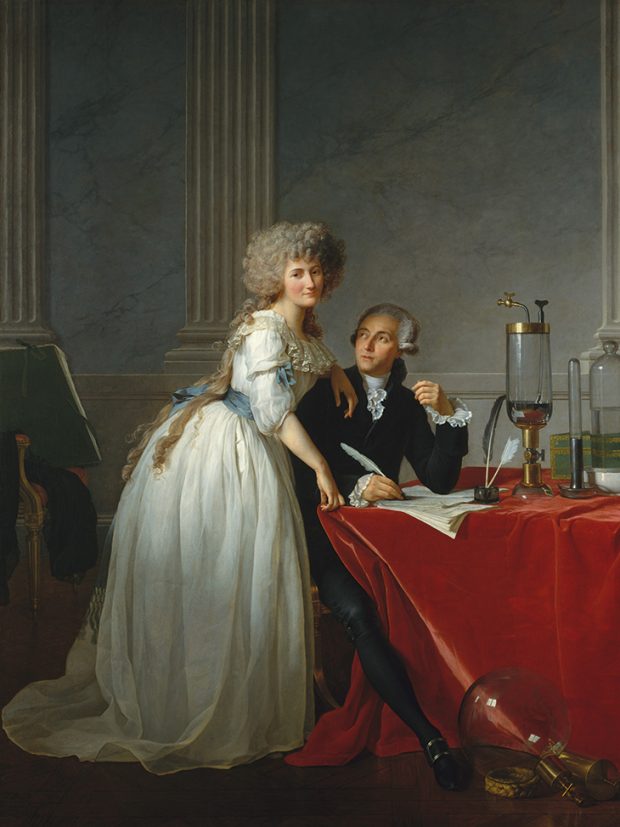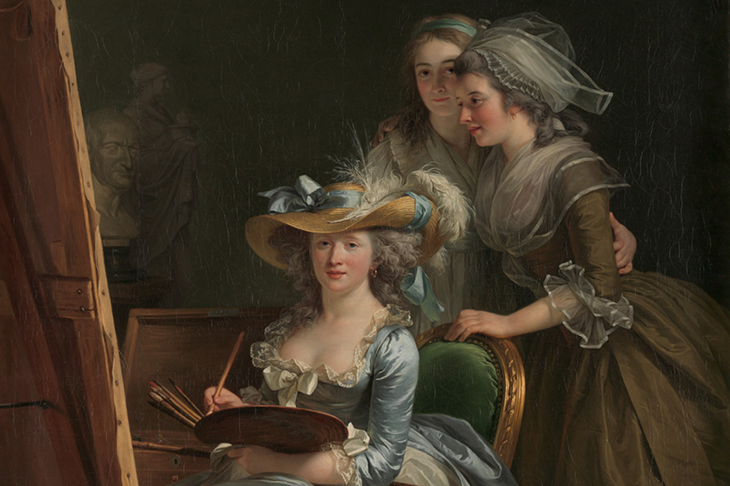 Thanks to Pierre Rosenberg’s Only in America (2006) and Yuriko Jackall’s America Collects… (2017; accompanying the exhibition of the same name) we now have a clear idea of the incomparable riches in French painting held by American museums. This welcome account of the foremost collection follows hard on the heels of Humphrey Wine’s equivalent volume on the National Gallery’s holdings. Indeed it is difficult not to see the collections in competitive terms – perhaps even in the context of the American War of Independence, in which, on the ‘my enemy’s enemy’ principle, France funded the rebellion against England at a cost resulting in its own revolution, but repaid in the soft diplomacy we see gathered here. New York acquired David’s Death of Socrates, while London makes do with Peyron sketches – almost a re-run of the 1787 Salon confrontation between the two artists: then as now it was obvious who was the better painter. That these masterpieces are not still in France has required not only Europe’s impoverishment, but also contributory negligence: when Labille-Guiard’s great self-portrait was offered to the Louvre in 1878, it was not merely declined (as Katharine Baetjer laconically reports), but assessed as ‘sans valeur artistique’.
Thanks to Pierre Rosenberg’s Only in America (2006) and Yuriko Jackall’s America Collects… (2017; accompanying the exhibition of the same name) we now have a clear idea of the incomparable riches in French painting held by American museums. This welcome account of the foremost collection follows hard on the heels of Humphrey Wine’s equivalent volume on the National Gallery’s holdings. Indeed it is difficult not to see the collections in competitive terms – perhaps even in the context of the American War of Independence, in which, on the ‘my enemy’s enemy’ principle, France funded the rebellion against England at a cost resulting in its own revolution, but repaid in the soft diplomacy we see gathered here. New York acquired David’s Death of Socrates, while London makes do with Peyron sketches – almost a re-run of the 1787 Salon confrontation between the two artists: then as now it was obvious who was the better painter. That these masterpieces are not still in France has required not only Europe’s impoverishment, but also contributory negligence: when Labille-Guiard’s great self-portrait was offered to the Louvre in 1878, it was not merely declined (as Katharine Baetjer laconically reports), but assessed as ‘sans valeur artistique’.
Self-Portrait with Two Pupils (1785), Adélaïde Labille-Guiard. Metropolitan Museum of Art, New York

Baetjer has just 408 pages to describe the 126 pictures (Wine: 624 pages for 72 pictures), leading to a sharp focus in the essays, aided by intelligent reliance on the museum’s excellent website. You have to consult the ‘object web page’ for ‘full’ bibliographies; only selections are presented here. But the publisher has gone too far in omitting an index: if a book of this nature is to appear on paper, it must have one. Room however is made for a long essay on the history of the Académie royale, much of which deals with the 17th century. Pitched at intermediate level, it is more accessible than Christian Michel’s recent account: but, although covering well-trodden territory, it fails to provide explanations that the text later requires. Thus, while the entries employ circumlocutions to avoid using the French term agréé, beginners are left baffled when La Live de Jully is described as ‘an associate member’ – one possible translation – while in fact his membership is honorary, a parallel system for amateurs which is not mentioned. The essay reinforces the widely prevalent view that the Académie royale is the be-all and end-all of dix-huitième painting, while the collection itself is less hierarchical and includes a generous selection of portraits.
I would have made room instead for an account of the development of the collection. There is no concordance with previous catalogues – Sterling in 1955 included 76 pictures from the 18th century, but 25 of these are now inexplicably omitted (presumably deaccessioned, but the website won’t tell you; only those worth more than $50,000 are listed in the annual reports). Even some catalogued by Baetjer in 1995 have disappeared. Of 126 paintings (from 1696 to 1816 – nine outside the period of the title, by 50 artists born between 1656 and 1774), only 19 seem to have been ‘purchased’ by the museum (and then mostly with specific gifts), so that almost the entire collection has depended on philanthropy (and the US tax system). American billionaires were simply following in the footsteps of the ancien régime financiers who commissioned these pictures to embellish their newly acquired nobility. That this has resulted in the coherence that would normally require the guiding hand of a visionary collector (but Jayne Wrightsman must be mentioned) or curator is due rather to the uniform taste of the dealers who supplied them: firms such as Duveen, Seligmann, Gimpel or, greatest of all, Wildenstein, through whose hands alone 43 of these pictures passed. (There are four or more each by the ‘big names’, Watteau, Nattier, Pater, Boucher, Greuze, Drouais, Fragonard, Robert, David, and few serious gaps.) How hard these dealers had to work is demonstrated by the early history (not in Baetjer) of the magnificent Coypel pastel, which Duveen sold in 1906 to a collector, Mrs T. Henry Mason, who returned it almost immediately (we should be grateful: her other returns required expensive restoration).
Antoine Laurent Lavoisier and His Wife (1788), Jacques-Louis David. Metropolitan Museum of Art, New York

Baetjer provides excellent summaries of the vast scholarship that has been applied to these works. Perhaps it is surprising that there is room for anything new to say about, for example, David’s portrait of Lavoisier and his wife, the one picture here that Rosenberg included in his 100 masterpieces: but no one seems to have noticed that the composition is so close to Les Offres séduisantes, an erotic print published in 1782.
Previous fanciful identifications of portraits have justly been reconsidered with scepticism, but I can suggest one solution: Saint-Aubin’s cryptic identification of ‘Mme de Saint-Maurice, femme d’un conseiller au parlement’. A search of the relevant lists shows that she can only be Éléonore de Beauterne (1742–1824), wife of the famous collector Bourgevin Vialart de Saint-Morys. Similarly I have recently published information about Marguerite Carraux [sic], the third figure in the Labille-Guiard, revealing her to be the illegitimate daughter of a Swiss farmer.
Establishing the identities of sitters and former owners reveals a few areas for further research. To take a single example, on p. 89 we are told ‘genealogical information is lacking and/or inconsistent’: but the point in question can be settled by consulting documents in the Archives nationales (the Cypierre marriage contract was signed on 18 August 1752). Such minutiae will not affect readers’ enjoyment of the book. I cannot however pass over the claim (p. 106) that Jean de Jullienne ‘was not particularly interested in pastels’, when he had one of the largest and most important pastel collections of his era (in addition to the beautiful Watteau). But we should certainly be thankful for the Met’s enlightened inclusion of pastels in a paintings catalogue – and for adding, since 2002, four great masterpieces in this medium when Europe showed no interest.
Beautifully produced, this book is a tribute to one of the world’s great museums, and offers a robust defence of its collections management policies and its commitment to scholarly publication.
Madame de Saint-Maurice (1776), Joseph Stifford Duplessis. Metropolitan Museum of Art, New York

French Paintings in the Metropolitan Museum of Art: From the Early Eighteenth Century through the Revolution by Katharine Baetjer is published by the Metropolitan Museum of Art.
From the April 2019 issue of Apollo. Preview and subscribe here.



